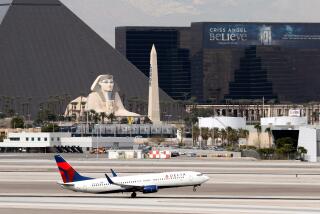Ebola scare: How clean are airline cabins?
- Share via
United Airlines, flown by the Dallas Ebola patient to the U.S., cites medical experts that there was “zero risk of transmission” on the flights.
Despite the reassurances, the Ebola case has focused attention on the procedures airlines use to keep cabins clean and safe for passengers.
Neither the Federal Aviation Administration, the U.S. Environmental Protection Agency nor the Occupational Safety and Health Administration mandate cleaning procedures for airline cabins.
“Nobody has standards for cleaning the inside,” said Arthur Kreitenberg, an orthopedic surgeon who invented a device to kill germs by showering ultraviolet light in airline cabins. “It’s frightening.”
The Centers for Disease Control and Prevention issued advisory guidelines last month on how airlines should deal with passengers who are infected with Ebola.
The guidelines recommend cleaning procedures but note that “the risk of spreading Ebola to passengers or crew on an aircraft is low because Ebola spreads by direct contact with infected body fluids. Ebola does not spread through the air like flu.”
United Airlines said the two planes that carried the Ebola patient Sept. 20 “remained overnight for a thorough cleaning including cleaning of lavatories and galleys with heavy-duty, all-purpose cleaners and wiping tray tables and armrests with disinfectant,” according to a statement.
Medical studies say germs can live on plastic surfaces, such as tray tables and lavatory door handles, for as long as 72 hours.
Airline cabins are typically not cleaned after every flight. Instead, industry experts say cleaning crews come through cabins overnight to vacuum the carpets and wipe down lavatories and tray tables.
A complete maintenance overhaul, known as a “D check” or “heavy maintenance visit,” includes replacing carpets and seat covers. Such an overhaul is scheduled every five years or so.
A large jet can weigh up to 300 pounds less after such a cleaning, according to the book “Full Upright and Locked Position” by Mark Gerchick, the former chief counsel of the FAA.
To read more about travel, tourism and the airline industry, follow me on Twitter at @hugomartin.
More to Read
Inside the business of entertainment
The Wide Shot brings you news, analysis and insights on everything from streaming wars to production — and what it all means for the future.
You may occasionally receive promotional content from the Los Angeles Times.











